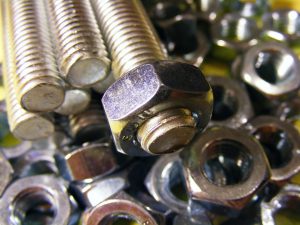
A nut if a fastener featuring a threaded, circular interior that’s used in conjunction with a bolt to secure multiple objects together. After inserting a bolt through the objects, a nut can be twisted onto the end of the bolt, thereby securing the objects. Unfortunately, it’s not uncommon for traditional nuts to loosen over time. If one or more of the connected objects vibrates, for example, those vibrations may knock the nut loose.
Some nuts, however, are designed to protect vibration-related loosening. Known as lock nuts, they are frequently used in applications where one or more of the joined objects produces vibrations.
What Is a Lock Nut?
Also known as a stiff nut, a lock nut is a special type of nut that doesn’t loosen when exposed to vibrations. In the past, companies would simply use two nuts in applications where vibrations are problematic. After inserting one nut onto the end of the bolt, they would place a second nut on the bolt. While the use of two nuts is effective at preventing vibration-related loosening, it’s not cost-effective for manufacturing companies that perform large-volume production operations. After all, each instance in which a bolt is used would require two nuts rather than one, thus doubling the cost of nuts for manufacturing companies.
Invented in the 1930s, lock nuts offer an easier and more cost-effective solution to protecting against vibration-related loosening. Using just one lock nut, manufacturing companies can secure multiple objects together without fear of vibrations loosening the nut. Lock nuts generally aren’t “free spinning,” meaning they require more than just manual twisting to remove. Even under heavy vibrations, they’ll remain stable and secure to the bolt on which they are used.
How Lock Nuts Work
Lock nuts feature a unique design that prevents them from loosening when exposed to vibrations. Traditional nuts simply consist of a basic threaded hole, so constant exposure to vibrations can knock them loose from the bolt on which they are placed. Lock nuts protect against loosening, however, by featuring a design that increases the nut’s resistance to vibrations.
There are several types of lock nuts, the most common of which include metal lock nuts and nylon-insert lock nuts. Metal lock nuts feature a crowned top that can be crimped to secure the nut in place. In comparison, nylon lock nuts feature a layer of nylon material covering the interior threading. When a nylon lock nut is placed on a bolt, the nylon fibers expand to grip the bolt.
No tags for this post.